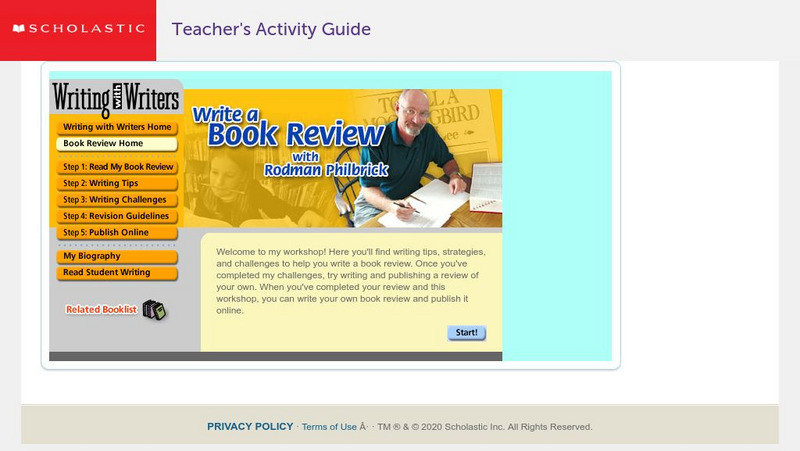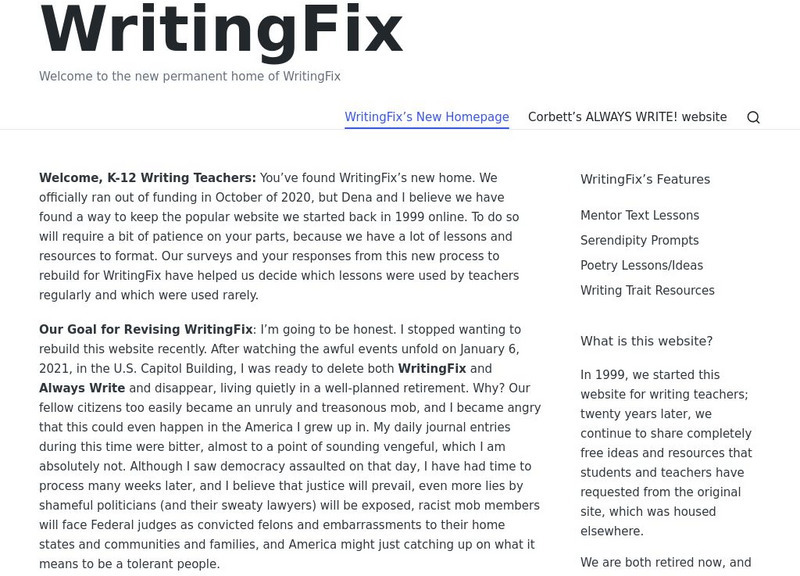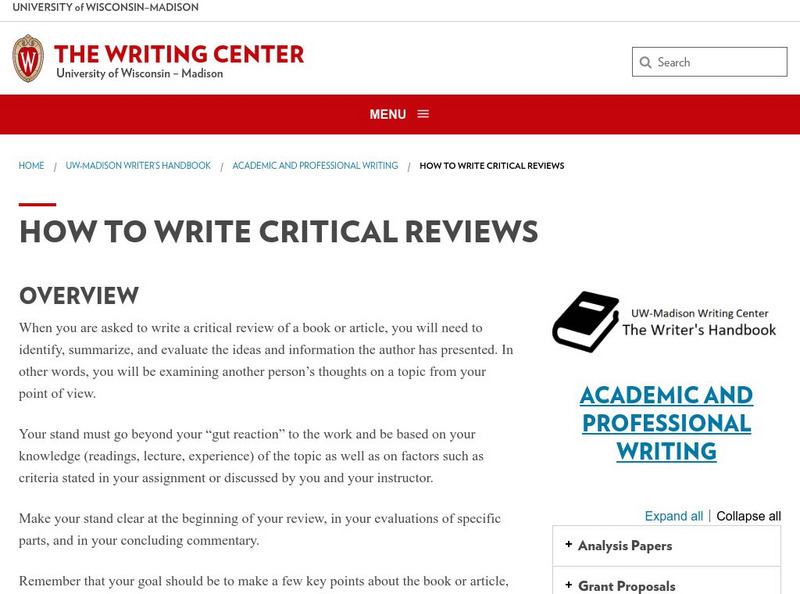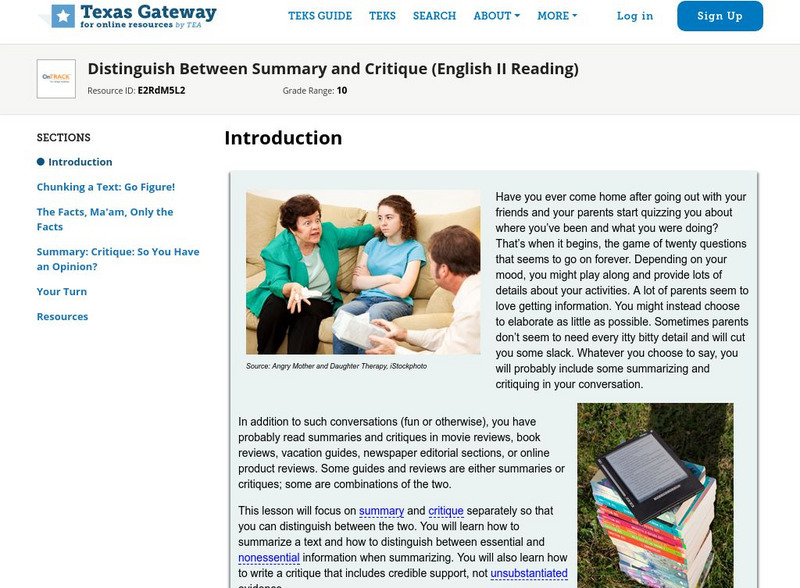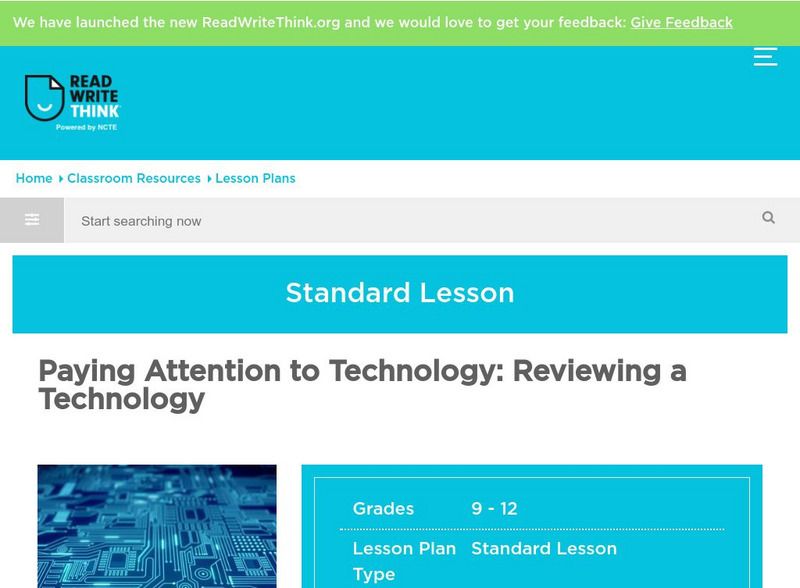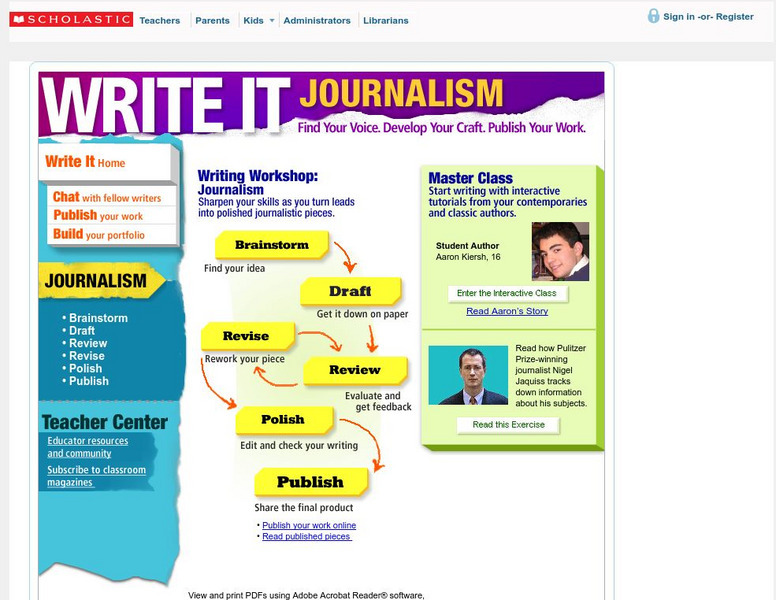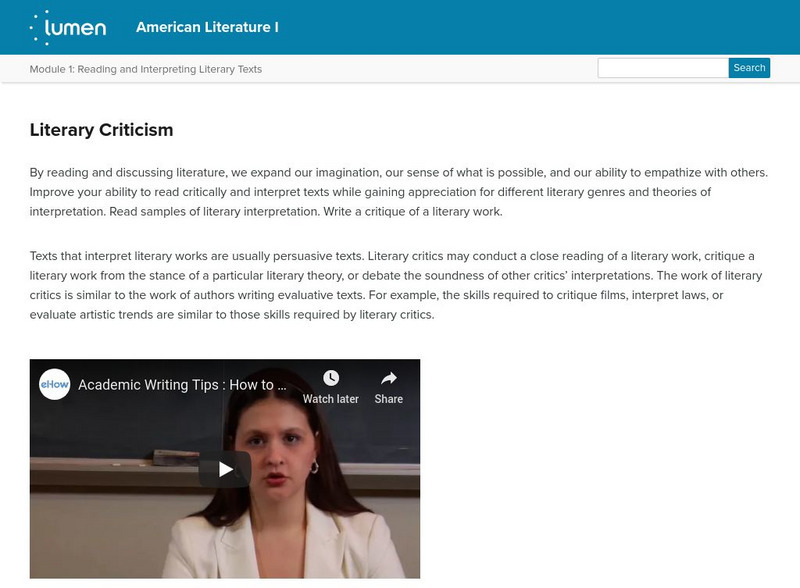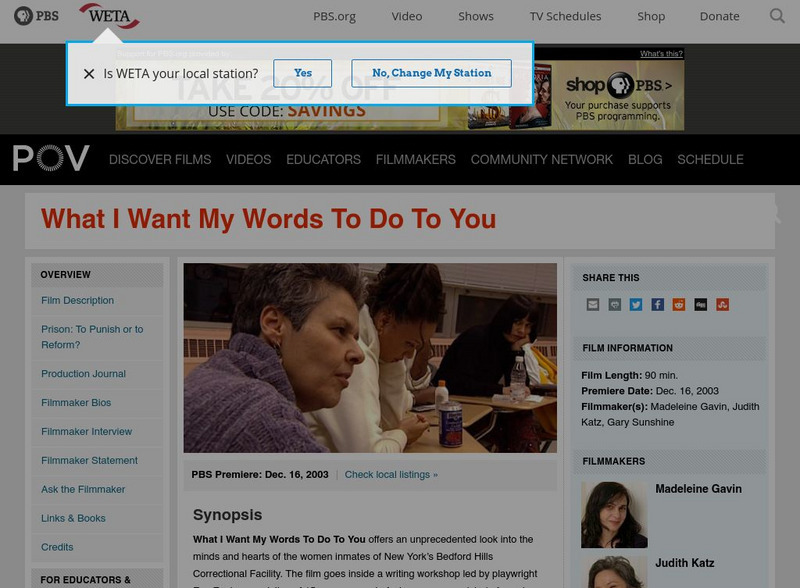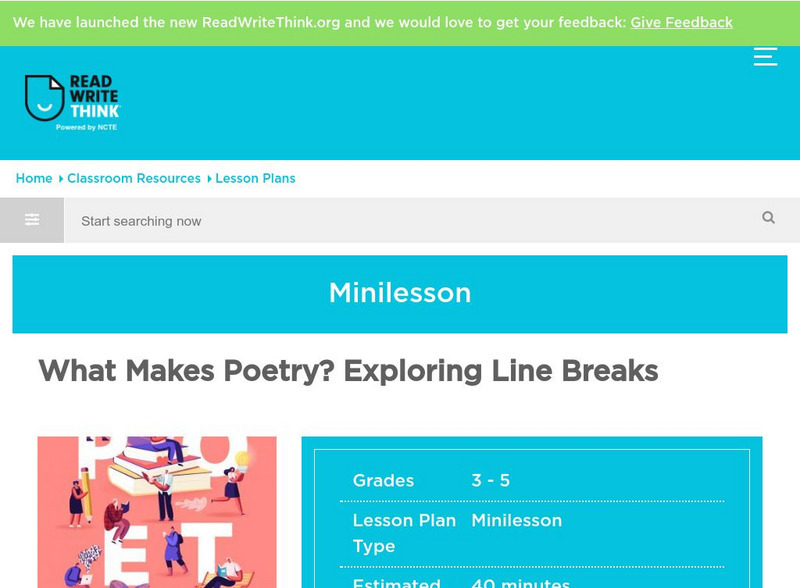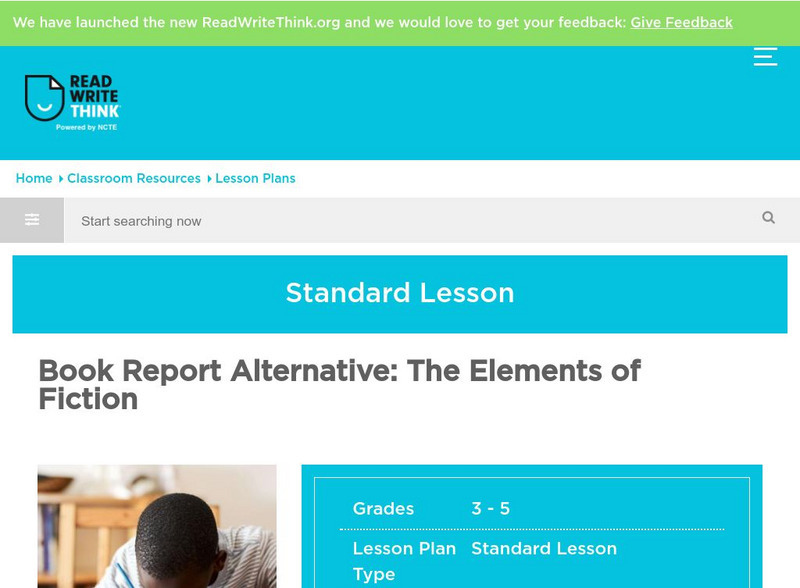EngageNY
TASC Transition Curriculum: Workshop 8
Lights, camera, action! Math educators consider how to improve their instruction by examining a model of the five-practice problem-solving model involving a movie theater. Participants examine cognitive demand in relation to problem...
Leaf Group
E How: How to Write a Self Assessment & Reflection Paper
This article by Kara Page explains how to write a self-assessment and reflection paper. W.9-10.9 Analysis/Reflection/Research
Texas Education Agency
Texas Gateway: Distinguish Between Summary and Critique (English Ii Reading)
This lesson will focus on summary and critique separately so that you can distinguish between the two. You will learn how to summarize a text and how to distinguish between essential and nonessential information when summarizing. You...
Scholastic
Scholastic: Writing With Writers: Write a Book Review With Rodman Philbrick
This online activity invites students to plan, draft, revise, and publish a book review. Important writing tips and a professional writing model, provided by the author Rodman Philbrick, are included. Plus, enjoy the online library of...
PBS
Pbs Learning Media: Abraham Lincoln: A Good Man? Or a Good Man!
In this instructional activity, young scholars use video from American Masters: Bill T. Jones: A Good Man along with primary sources to investigate the life of Lincoln and write a one page argument essay on whether Lincoln was "a good man."
Writing Fix
Writing Fix: Writing Fix Homepage
Have you ever needed someone to help you out with your writing? This site offers help to students and teachers. The lessons and resources are organized based on the 6 Writing Traits model. An especially interesting feature of the site is...
Texas Education Agency
Texas Gateway: Distinguish Between Summary and Critique (English I Reading)
Learn how to summarize a text in contrast to writing a critique that takes a position.
Texas Education Agency
Texas Gateway: Distinguish Between Summary and Critique (English I Reading)
In this lesson, students will learn how to write an effective summary using reading strategies to help ensure that the summary contains enough information without including unnecessary details or personal opinions. You will also learn...
University of Wisconsin
University of Wisconsin Madison: Writing Center: How to Write Critical Reviews
This site provides the viewer with a step-by-step guide to writing critical reviews for non-fiction works. Its steps include analyzing the assignment as well as writing a clear introduction, body, and conclusion. Links to other writing...
ReadWriteThink
Read Write Think: Cover to Cover: Comparing Books to Movies
A 7-lesson unit where learners critically analyze how a film adaptation portrays a novel to see what impact it had on the retell of the story. They then design a movie DVD cover and write a DVD insert based on what they have learned. The...
Texas Education Agency
Texas Gateway: Distinguish Between Summary and Critique (English Ii Reading)
Smmarize a text and distinguish between a summary and a critique, identifying nonessential information in a summary, and unsubstantiated opinions in a critique.
Other
Tidewater Community College: Book or Article Review or Critique Guidelines
Many students are not sure what type of information to include in a book or article review. This site provides some general guidelines. It covers not only the type of content to be included but also the format.
University of Wisconsin
University of Wisconsin Madison: Writing Center: Reading a Book to Review It
Advice on steps to take and things to think about while reading a book to be reviewed. These directions will be particularly useful when reviewing non-fiction, but can be modified to work for fiction, too.
University of Wisconsin
University of Wisconsin Madison: Writing Center: Peer Reviews
Bulleted guidelines for conducting a peer review on a draft. Emphasizes knowing the intent of the writer, controlling the content of the review, and maintaining a polite, helpful tone.
ReadWriteThink
Read Write Think: Paying Attention to Technology Reviewing a Technology
Contains plans for five lessons that ask students to write reviews of pieces of technology (cell phones, webcams, ink pens, satellite dishes, etc.) like they would write reviews of books. In addition to objectives and standards, this...
Scholastic
Scholastic: Write It: Journalism
This workshop launches will launch students into the writing process. Read advice from Pulitzer Prize winning journalist Nigel Jaquiss, and read work from other students. The Sandwich Critique is an excellent way to peer review. Finally,...
PBS
Pbs Learning Media: Math + Arts: Symmetry, Reflective Drawing, and Totem Poles
In this lesson, young scholars will create a colored pencil drawing utilizing symmetry and forms characteristic of Northwest Coast art and write a critique of their work. Media resources and teacher materials are included.
Lumen Learning
Lumen: Reading and Interpreting Literary Texts: Literary Criticism
This lesson focuses on how to write a literary criticism, the different theories and approaches to literary criticism, and their standard format.
University of Toronto (Canada)
University of Toronto: The Book Review or Article Critique
This site presents a series of questions to ask yourself before writing a book review or article critique. Most appropriate for non-fiction works.
PBS
Pbs Teachers:what I Want My Words to Do to You: Using Writing to Resolve Conflic
Use writing as a conflict resolution strategy and re-writing as a way to improve writing skills. Learn to respectfully critique another's writing and consider situations from a variety of perspectives.
ReadWriteThink
Read Write Think: Attn to Technology: Exploring a Fictional Technology Lesson Plan
Taking a critical look at our responses to technology and technological advancement is the intent of this ReadWriteThink lesson, designed for 3 50-minute classes. Includes student survey, handouts, interactive, and evaluation rubric.
ReadWriteThink
Read Write Think: What Makes Poetry? Exploring Line Breaks
This lesson explains how analyzing poetry is a many-layered process. This lesson introduces the special characteristics of poetry and leads learners through a look at how poems are structured and why. Includes links to poems and web...
British Library
British Library: Discovering Literature: An Introduction to "She Stoops to Conquer"
Oliver Goldsmith published several critiques of audiences and playwrights before writing a laughing comedy that was the triumph of its season and that continues to be performed today. This article introduces "She Stoops to Conquer",...
ReadWriteThink
Read Write Think: Book Report Alternative: The Elements of Fiction
Analyzing a book takes the form of creating their own when students complete this activity. The stated goal is to help students "Read like writers." Includes link to a template for student use.



